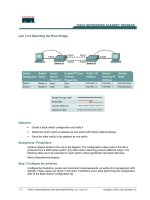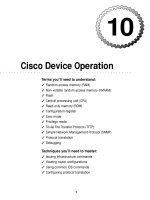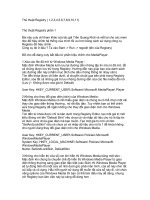Tài liệu Linux Device Drivers-Chapter 4 : Debugging Techniques pptx
Bạn đang xem bản rút gọn của tài liệu. Xem và tải ngay bản đầy đủ của tài liệu tại đây (424.47 KB, 66 trang )
Chapter 4 : Debugging Techniques
One of the most compelling problems for anyone writing kernel code is how
to approach debugging. Kernel code cannot be easily executed under a
debugger, nor can it be easily traced, because it is a set of functionalities not
related to a specific process. Kernel code errors can also be exceedingly hard
to reproduce and can bring down the entire system with them, thus
destroying much of the evidence that could be used to track them down.
This chapter introduces techniques you can use to monitor kernel code and
trace errors under such trying circumstances.
Debugging by Printing
The most common debugging technique is monitoring, which in applications
programming is done by calling printf at suitable points. When you are
debugging kernel code, you can accomplish the same goal with printk.
printk
We used the printk function in earlier chapters with the simplifying
assumption that it works like printf. Now it's time to introduce some of the
differences.
One of the differences is that printk lets you classify messages according to
their severity by associating different loglevels, or priorities, with the
messages. You usually indicate the loglevel with a macro. For example,
KERN_INFO, which we saw prepended to some of the earlier print
statements, is one of the possible loglevels of the message. The loglevel
macro expands to a string, which is concatenated to the message text at
compile time; that's why there is no comma between the priority and the
format string in the following examples. Here are two examples of
printkcommands, a debug message and a critical message:
printk(KERN_DEBUG "Here I am: %s:%i\n", __FILE__,
__LINE_&_);
printk(KERN_CRIT "I'm trashed; giving up on %p\n",
ptr);
There are eight possible loglevel strings, defined in the header
<linux/kernel.h>:
KERN_EMERG
Used for emergency messages, usually those that precede a crash.
KERN_ALERT
A situation requiring immediate action.
KERN_CRIT
Critical conditions, often related to serious hardware or software
failures.
KERN_ERR
Used to report error conditions; device drivers will often use
KERN_ERR to report hardware difficulties.
KERN_WARNING
Warnings about problematic situations that do not, in themselves,
create serious problems with the system.
KERN_NOTICE
Situations that are normal, but still worthy of note. A number of
security-related conditions are reported at this level.
KERN_INFO
Informational messages. Many drivers print information about the
hardware they find at startup time at this level.
KERN_DEBUG
Used for debugging messages.
Each string (in the macro expansion) represents an integer in angle brackets.
Integers range from 0 to 7, with smaller values representing higher priorities.
A printk statement with no specified priority defaults to
DEFAULT_MESSAGE_LOGLEVEL, specified in kernel/printk.c as an
integer. The default loglevel value has changed several times during Linux
development, so we suggest that you always specify an explicit loglevel.
Based on the loglevel, the kernel may print the message to the current
console, be it a text-mode terminal, a serial line printer, or a parallel printer.
If the priority is less than the integer variable console_loglevel, the
message is displayed. If both klogd and syslogd are running on the system,
kernel messages are appended to /var/log/messages (or otherwise treated
depending on your syslogdconfiguration), independent of
console_loglevel. If klogd is not running, the message won't reach
user space unless you read /proc/kmsg.
The variable console_loglevel is initialized to
DEFAULT_CONSOLE_LOGLEVEL and can be modified through the
sys_syslog system call. One way to change it is by specifying the -c switch
when invoking klogd, as specified in the klogd manpage. Note that to change
the current value, you must first kill klogdand then restart it with the -c
option. Alternatively, you can write a program to change the console
loglevel. You'll find a version of such a program in misc-progs/setlevel.c in
the source files provided on the O'Reilly FTP site. The new level is specified
as an integer value between 1 and 8, inclusive. If it is set to 1, only messages
of level 0 (KERN_EMERG) will reach the console; if it is set to 8, all
messages, including debugging ones, will be displayed.
You'll probably want to lower the loglevel if you work on the console and
you experience a kernel fault (see "Debugging System Faults" later in this
chapter), because the fault-handling code raises the console_loglevel
to its maximum value, causing every subsequent message to appear on the
console. You'll want to raise the loglevel if you need to see your debugging
messages; this is useful if you are developing kernel code remotely and the
text console is not being used for an interactive session.
From version 2.1.31 on it is possible to read and modify the console loglevel
using the text file /proc/sys/kernel/printk. The file hosts four integer values.
You may be interested in the first two: the current console loglevel and the
default level for messages. With recent kernels, for instance, you can cause
all kernel messages to appear at the console by simply entering
# echo 8 > /proc/sys/kernel/printk
If you run 2.0, however, you still need the setlevel tool.
It should now be apparent why the hello.c sample had the <1> markers; they
are there to make sure that the messages appear on the console.
Linux allows for some flexibility in console logging policies by letting you
send messages to a specific virtual console (if your console lives on the text
screen). By default, the "console" is the current virtual terminal. To select a
different virtual terminal to receive messages, you can issue
ioctl(TIOCLINUX) on any console device. The following program,
setconsole, can be used to choose which console receives kernel messages; it
must be run by the superuser and is available in the misc-progs directory.
This is how the program works:
int main(int argc, char **argv)
{
char bytes[2] = {11,0}; /* 11 is the TIOCLINUX
cmd number */
if (argc==2) bytes[1] = atoi(argv[1]); /* the
chosen console */
else {
fprintf(stderr, "%s: need a single
arg\n",argv[0]); exit(1);
}
if (ioctl(STDIN_FILENO, TIOCLINUX, bytes)<0) {
/* use stdin */
fprintf(stderr,"%s: ioctl(stdin,
TIOCLINUX): %s\n",
argv[0], strerror(errno));
exit(1);
}
exit(0);
}
setconsole uses the special ioctl command TIOCLINUX, which implements
Linux-specific functions. To use TIOCLINUX, you pass it an argument that
is a pointer to a byte array. The first byte of the array is a number that
specifies the requested subcommand, and the following bytes are
subcommand specific. In setconsole, subcommand 11 is used, and the next
byte (stored in bytes[1]) identifies the virtual console. The complete
description of TIOCLINUX can be found in drivers/char/tty_io.c, in the
kernel sources.
How Messages Get Logged
The printk function writes messages into a circular buffer that is
LOG_BUF_LEN (defined in kernel/printk.c) bytes long. It then wakes any
process that is waiting for messages, that is, any process that is sleeping in
the syslog system call or that is reading /proc/kmsg. These two interfaces to
the logging engine are almost equivalent, but note that reading from
/proc/kmsg consumes the data from the log buffer, whereas the syslog
system call can optionally return log data while leaving it for other processes
as well. In general, reading the /proc file is easier, which is why it is the
default behavior for klogd.
If you happen to read the kernel messages by hand, after stopping klogd
you'll find that the /proc file looks like a FIFO, in that the reader blocks,
waiting for more data. Obviously, you can't read messages this way if klogd
or another process is already reading the same data because you'll contend
for it.
If the circular buffer fills up, printk wraps around and starts adding new data
to the beginning of the buffer, overwriting the oldest data. The logging
process thus loses the oldest data. This problem is negligible compared with
the advantages of using such a circular buffer. For example, a circular buffer
allows the system to run even without a logging process, while minimizing
memory waste by overwriting old data should nobody read it. Another
feature of the Linux approach to messaging is that printk can be invoked
from anywhere, even from an interrupt handler, with no limit on how much
data can be printed. The only disadvantage is the possibility of losing some
data.
If the klogd process is running, it retrieves kernel messages and dispatches
them to syslogd, which in turn checks /etc/syslog.conf to find out how to deal
with them. syslogd differentiates between messages according to a facility
and a priority; allowable values for both the facility and the priority are
defined in <sys/syslog.h>. Kernel messages are logged by the
LOG_KERN facility, at a priority corresponding to the one used in printk (for
example, LOG_ERR is used for KERN_ERR messages). If klogd isn't
running, data remains in the circular buffer until someone reads it or the
buffer overflows.
If you want to avoid clobbering your system log with the monitoring
messages from your driver, you can either specify the -f (file) option to
klogd to instruct it to save messages to a specific file, or modify
/etc/syslog.conf to suit your needs. Yet another possibility is to take the
brute-force approach: kill klogd and verbosely print messages on an unused
virtual terminal,[21] or issue the command cat /proc/kmsg from an unused
xterm.
[21]For example, use setlevel 8; setconsole 10 to set up terminal 10 to
display messages.
Turning the Messages On and Off
During the early stages of driver development, printk can help considerably
in debugging and testing new code. When you officially release the driver,
on the other hand, you should remove, or at least disable, such print
statements. Unfortunately, you're likely to find that as soon as you think you
no longer need the messages and remove them, you'll implement a new
feature in the driver (or somebody will find a bug) and you'll want to turn at
least one of the messages back on. There are several ways to solve both
issues, to globally enable or disable your debug messages and to turn
individual messages on or off.
Here we show one way to code printk calls so you can turn them on and off
individually or globally; the technique depends on defining a macro that
resolves to a printk (or printf) call when you want it to.
Each print statement can be enabled or disabled by removing or
adding a single letter to the macro's name.
All the messages can be disabled at once by changing the value of the
CFLAGS variable before compiling.
The same print statement can be used in kernel code and user-level
code, so that the driver and test programs can be managed in the same
way with regard to extra messages.
The following code fragment implements these features and comes directly
from the header scull.h.
#undef PDEBUG /* undef it, just in case
*/
#ifdef SCULL_DEBUG
# ifdef __KERNEL__
/* This one if debugging is on, and kernel
space */
# define PDEBUG(fmt, args...) printk( KERN_DEBUG
"scull: " fmt,
## args)
# else
/* This one for user space */
# define PDEBUG(fmt, args...) fprintf(stderr,
fmt, ## args)
# endif
#else
# define PDEBUG(fmt, args...) /* not debugging:
nothing */
#endif
#undef PDEBUGG
#define PDEBUGG(fmt, args...) /* nothing: it's a
placeholder */
The symbol PDEBUG depends on whether or not SCULL_DEBUG is defined,
and it displays information in whatever manner is appropriate to the
environment where the code is running: it uses the kernel call printk when
it's in the kernel, and the libc call fprintf to the standard error when run in
user space. The PDEBUGG symbol, on the other hand, does nothing; it can
be used to easily "comment" print statements without removing them
entirely.
To simplify the process further, add the following lines to your makefile:
# Comment/uncomment the following line to
disable/enable debugging
DEBUG = y
# Add your debugging flag (or not) to CFLAGS
ifeq ($(DEBUG),y)
DEBFLAGS = -O -g -DSCULL_DEBUG # "-O" is needed
to expand inlines
else
DEBFLAGS = -O2
endif
CFLAGS += $(DEBFLAGS)
The macros shown in this section depend on a gcc extension to the ANSI C
preprocessor that supports macros with a variable number of arguments.
This gcc dependency shouldn't be a problem because the kernel proper
depends heavily on gcc features anyway. In addition, the makefile depends
on GNU's version of make; once again, the kernel already depends on GNU
make, so this dependency is not a problem.
If you're familiar with the C preprocessor, you can expand on the given
definitions to implement the concept of a "debug level," defining different
levels and assigning an integer (or bit mask) value to each level to determine
how verbose it should be.
But every driver has its own features and monitoring needs. The art of good
programming is in choosing the best trade-off between flexibility and
efficiency, and we can't tell what is the best for you. Remember that
preprocessor conditionals (as well as constant expressions in the code) are
executed at compile time, so you must recompile to turn messages on or off.
A possible alternative is to use C conditionals, which are executed at runtime
and therefore permit you to turn messaging on and off during program
execution. This is a nice feature, but it requires additional processing every
time the code is executed, which can affect performance even when the
messages are disabled. Sometimes this performance hit is unacceptable.
The macros shown in this section have proven themselves useful in a
number of situations, with the only disadvantage being the requirement to
recompile a module after any changes to its messages.
Debugging by Querying
The previous section described how printk works and how it can be used.
What it didn't talk about are its disadvantages.
A massive use of printk can slow down the system noticeably, because
syslogd keeps syncing its output files; thus, every line that is printed causes a
disk operation. This is the right implementation from syslogd's perspective.
It tries to write everything to disk in case the system crashes right after
printing the message; however, you don't want to slow down your system
just for the sake of debugging messages. This problem can be solved by
prefixing the name of your log file as it appears in /etc/syslogd.conf with a
minus.[22] The problem with changing the configuration file is that the
modification will likely remain there after you are done debugging, even
though during normal system operation you do want messages to be flushed
to disk as soon as possible. An alternative to such a permanent change is
running a program other than klogd (such as cat /proc/kmsg, as suggested
earlier), but this may not provide a suitable environment for normal system
operation.
[22]The minus is a "magic" marker to prevent syslogd from flushing the file
to disk at every new message, documented in syslog.conf(5), a manual page
worth reading.
More often than not, the best way to get relevant information is to query the
system when you need the information, instead of continually producing
data. In fact, every Unix system provides many tools for obtaining system
information: ps, netstat, vmstat, and so on.
Two main techniques are available to driver developers for querying the
system: creating a file in the /procfilesystem and using the ioctl driver
method. You may use devfs as an alternative to /proc, but /proc is an easier
tool to use for information retrieval.
Using the /proc Filesystem
The /proc filesystem is a special, software-created filesystem that is used by
the kernel to export information to the world. Each file under /procis tied to
a kernel function that generates the file's "contents" on the fly when the file
is read. We have already seen some of these files in action; /proc/modules,
for example, always returns a list of the currently loaded modules.
/proc is heavily used in the Linux system. Many utilities on a modern Linux
distribution, such as ps, top, and uptime, get their information from /proc.
Some device drivers also export information via /proc, and yours can do so
as well. The /proc filesystem is dynamic, so your module can add or remove
entries at any time.
Fully featured /proc entries can be complicated beasts; among other things,
they can be written to as well as read from. Most of the time, however, /proc
entries are read-only files. This section will concern itself with the simple
read-only case. Those who are interested in implementing something more
complicated can look here for the basics; the kernel source may then be
consulted for the full picture.
All modules that work with /proc should include <linux/proc_fs.h>
to define the proper functions.
To create a read-only /proc file, your driver must implement a function to
produce the data when the file is read. When some process reads the file
(using the readsystem call), the request will reach your module by means of
one of two different interfaces, according to what you registered. We'll leave
registration for later in this section and jump directly to the description of the
reading interfaces.
In both cases the kernel allocates a page of memory (i.e., PAGE_SIZE
bytes) where the driver can write data to be returned to user space.
The recommended interface is read_proc, but an older interface named
get_info also exists.
int (*read_proc)(char *page, char **start, off_t
offset, int count, int *eof, void *data);
The page pointer is the buffer where you'll write your data; start
is used by the function to say where the interesting data has been
written in page (more on this later); offset and count have the
same meaning as in the read implementation. The eof argument
points to an integer that must be set by the driver to signal that it has
no more data to return, while data is a driver-specific data pointer
you can use for internal bookkeeping.[23] The function is available in
version 2.4 of the kernel, and 2.2 as well if you use our
sysdep.hheader.
[23]We'll find several of these pointers throughout the book; they
represent the "object" involved in this action and correspond
somewhat to this in C++.
int (*get_info)(char *page, char **start, off_t
offset, int count);
get_info is an older interface used to read from a /proc file. The
arguments all have the same meaning as for read_proc. What it lacks
is the pointer to report end-of-file and the object-oriented flavor
brought in by the data pointer. The function is available in all the
kernel versions we are interested in (although it had an extra unused
argument in its 2.0 implementation).
Both functions should return the number of bytes of data actually placed in
the page buffer, just like the read implementation does for other files.
Other output values are *eof and *start. eof is a simple flag, but the
use of the start value is somewhat more complicated.
The main problem with the original implementation of user extensions to the
/proc filesystem was use of a single memory page for data transfer. This
limited the total size of a user file to 4 KB (or whatever was appropriate for
the host platform). The start argument is there to implement large data
files, but it can be ignored.
If your proc_read function does not set the *start pointer (it starts out
NULL), the kernel assumes that the offset parameter has been ignored and
that the data page contains the whole file you want to return to user space. If,
on the other hand, you need to build a bigger file from pieces, you can set
*start to be equal to page so that the caller knows your new data is
placed at the beginning of the buffer. You should then, of course, skip the
first offset bytes of data, which will have already been returned in a
previous call.
There has long been another major issue with /proc files, which start is
meant to solve as well. Sometimes the ASCII representation of kernel data
structures changes between successive calls to read, so the reader process
could find inconsistent data from one call to the next. If *start is set to a
small integer value, the caller will use it to increment filp->f_pos
independently of the amount of data you return, thus making f_pos an
internal record number of your read_proc or get_infoprocedure. If, for
example, your read_procfunction is returning information from a big array
of structures, and five of those structures were returned in the first call,
start could be set to 5. The next call will provide that same value as the
offset; the driver then knows to start returning data from the sixth structure
in the array. This is defined as a "hack" by its authors and can be seen in
fs/proc/generic.c.
Time for an example. Here is a simple read_procimplementation for the
scull device:
int scull_read_procmem(char *buf, char **start,
off_t offset,
int count, int *eof, void *data)
{
int i, j, len = 0;
int limit = count - 80; /* Don't print more
than this */
for (i = 0; i < scull_nr_devs && len <= limit;
i++) {
Scull_Dev *d = &scull_devices[i];
if (down_interruptible(&d->sem))
return -ERESTARTSYS;
len += sprintf(buf+len,"\nDevice %i: qset
%i, q %i, sz %li\n",
i, d->qset, d->quantum, d-
>size);
for (; d && len <= limit; d = d->next) { /*
scan the list */
len += sprintf(buf+len, " item at %p,
qset at %p\n", d,
d->data);
if (d->data && !d->next) /* dump only
the last item
- save space */
for (j = 0; j < d->qset; j++) {
if (d->data[j])
len += sprintf(buf+len,"
% 4i: %8p\n",
j,d->data[j]);
}
}
up(&scull_devices[i].sem);
}
*eof = 1;
return len;
}
This is a fairly typical read_procimplementation. It assumes that there will
never be a need to generate more than one page of data, and so ignores the
start and offset values. It is, however, careful not to overrun its buffer,
just in case.
A /proc function using the get_info interface would look very similar to the
one just shown, with the exception that the last two arguments would be
missing. The end-of-file condition, in this case, is signaled by returning less
data than the caller expects (i.e., less than count).
Once you have a read_proc function defined, you need to connect it to an
entry in the /prochierarchy. There are two ways of setting up this
connection, depending on what versions of the kernel you wish to support.
The easiest method, only available in the 2.4 kernel (and 2.2 too if you use
our sysdep.h header), is to simply call create_proc_read_entry. Here is the
call used by scull to make its /proc function available as /proc/scullmem:
create_proc_read_entry("scullmem",
0 /* default mode */,
NULL /* parent dir */,
scull_read_procmem,
NULL /* client data */);
The arguments to this function are, as shown, the name of the /proc entry,
the file permissions to apply to the entry (the value 0 is treated as a special
case and is turned to a default, world-readable mask), the
proc_dir_entry pointer to the parent directory for this file (we use
NULL to make the driver appear directly under /proc), the pointer to the
read_proc function, and the data pointer that will be passed back to the
read_proc function.
The directory entry pointer can be used to create entire directory hierarchies
under /proc. Note, however, that an entry may be more easily placed in a
subdirectory of /proc simply by giving the directory name as part of the
name of the entry -- as long as the directory itself already exists. For
example, an emerging convention says that /proc entries associated with
device drivers should go in the subdirectory driver/; scull could place its
entry there simply by giving its name as driver/scullmem.
Entries in /proc, of course, should be removed when the module is unloaded.
remove_proc_entryis the function that undoes what create_proc_read_entry
did:
remove_proc_entry("scullmem", NULL /* parent dir
*/);
The alternative method for creating a /proc entry is to create and initialize a
proc_dir_entry structure and pass it to proc_register_dynamic(version
2.0) or proc_register (version 2.2, which assumes a dynamic file if the inode
number in the structure is 0). As an example, consider the following code
that scull uses when compiled against 2.0 headers:
static int scull_get_info(char *buf, char **start,
off_t offset,
int len, int unused)
{
int eof = 0;
return scull_read_procmem (buf, start, offset,
len, &eof, NULL);
}
struct proc_dir_entry scull_proc_entry = {
namelen: 8,
name: "scullmem",
mode: S_IFREG | S_IRUGO,
nlink: 1,
get_info: scull_get_info,
};
static void scull_create_proc()
{
proc_register_dynamic(&proc_root,
&scull_proc_entry);
}
static void scull_remove_proc()
{
proc_unregister(&proc_root,
scull_proc_entry.low_ino);
}
The code declares a function using the get_infointerface and fills in a
proc_dir_entry structure that is registered with the filesystem.
This code provides compatibility across the 2.0 and 2.2 kernels, with a little
support from macro definitions in sysdep.h. It uses the get_info interface
because the 2.0 kernel did not support read_proc. Some more work with
#ifdef could have made it use read_proc with Linux 2.2, but the benefits
would be minor.
The ioctl Method
ioctl, which we show you how to use in the next chapter, is a system call that
acts on a file descriptor; it receives a number that identifies a command to be
performed and (optionally) another argument, usually a pointer.
As an alternative to using the /proc filesystem, you can implement a few
ioctl commands tailored for debugging. These commands can copy relevant
data structures from the driver to user space, where you can examine them.
Using ioctl this way to get information is somewhat more difficult than
using /proc, because you need another program to issue the ioctl and display
the results. This program must be written, compiled, and kept in sync with
the module you're testing. On the other hand, the driver's code is easier than
what is needed to implement a /proc file
There are times when ioctl is the best way to get information, because it runs
faster than reading /proc. If some work must be performed on the data
before it's written to the screen, retrieving the data in binary form is more
efficient than reading a text file. In addition, ioctl doesn't require splitting
data into fragments smaller than a page.
Another interesting advantage of the ioctlapproach is that information-
retrieval commands can be left in the driver even when debugging would
otherwise be disabled. Unlike a /proc file, which is visible to anyone who
looks in the directory (and too many people are likely to wonder "what that
strange file is"), undocumented ioctl commands are likely to remain
unnoticed. In addition, they will still be there should something weird
happen to the driver. The only drawback is that the module will be slightly
bigger.
Debugging by Watching
Sometimes minor problems can be tracked down by watching the behavior
of an application in user space. Watching programs can also help in building
confidence that a driver is working correctly. For example, we were able to
feel confident about scullafter looking at how its read implementation
reacted to read requests for different amounts of data.
There are various ways to watch a user-space program working. You can run
a debugger on it to step through its functions, add print statements, or run the
program under strace. Here we'll discuss just the last technique, which is
most interesting when the real goal is examining kernel code.
The strace command is a powerful tool that shows all the system calls issued
by a user-space program. Not only does it show the calls, but it can also
show the arguments to the calls, as well as return values in symbolic form.
When a system call fails, both the symbolic value of the error (e.g.,
ENOMEM) and the corresponding string (Out of memory) are displayed.
stracehas many command-line options; the most useful of which are -t to









